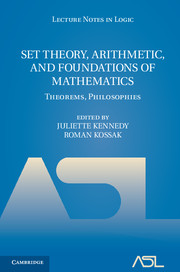Book contents
- Frontmatter
- Contents
- Introduction
- Historical remarks on Suslin's problem
- The continuum hypothesis, the generic-multiverse of sets, and the Ω conjecture
- ω-models of finite set theory
- Tennenbaum's theorem for models of arithmetic
- Hierarchies of subsystems of weak arithmetic
- Diophantine correct open induction
- Tennenbaum's theorem and recursive reducts
- History of constructivism in the 20th century
- A very short history of ultrafinitism
- Sue Toledo's notes of her conversations with Gödel in 1972–5
- Stanley Tennenbaum's Socrates
- Tennenbaum's proof of the irrationality of √2
- References
History of constructivism in the 20th century
Published online by Cambridge University Press: 07 October 2011
- Frontmatter
- Contents
- Introduction
- Historical remarks on Suslin's problem
- The continuum hypothesis, the generic-multiverse of sets, and the Ω conjecture
- ω-models of finite set theory
- Tennenbaum's theorem for models of arithmetic
- Hierarchies of subsystems of weak arithmetic
- Diophantine correct open induction
- Tennenbaum's theorem and recursive reducts
- History of constructivism in the 20th century
- A very short history of ultrafinitism
- Sue Toledo's notes of her conversations with Gödel in 1972–5
- Stanley Tennenbaum's Socrates
- Tennenbaum's proof of the irrationality of √2
- References
Summary
§1. Introduction. In this survey of the history of constructivism. more space has been devoted to early developments (up till ca. 1965) than to the work of the later decades. Not only because most of the concepts and general insights have emerged before 1965, but also for practical reasons: much of the work since 1965 is of a too technical and complicated nature to be described adequately within the limits of this article.
Constructivism is a point of view (or an attitude) concerning the methods and objects of mathematics which is normative: not only does it interpret existing mathematics according to certain principles, but it also rejects methods and results not conforming to such principles as unfounded or speculative (the rejection is not always absolute, but sometimes only a matter of degree: a decided preference for constructive concepts and methods). In this sense the various forms of constructivism are all ‘ideological’ in character.
Constructivism as a specific viewpoint emerges in the final quarter of the 19th century, and may be regarded as a reaction to the rapidly increasing use of highly abstract concepts and methods of proof in mathematics, a trend exemplified by the works of R.Dedekind and G. Cantor.
The mathematics before the last quarter of the 19th century is, from the viewpoint of today, in the main constructive, with the notable exception of geometry, where proof by contradiction was commonly accepted and widely employed.
- Type
- Chapter
- Information
- Set Theory, Arithmetic, and Foundations of MathematicsTheorems, Philosophies, pp. 150 - 179Publisher: Cambridge University PressPrint publication year: 2011
References
- 6
- Cited by



